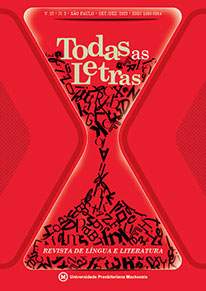The “bloody fact” (“fato cruento”) and the experiment of tragic continuity in the short stories of O cego e a dançarina, by João Gilberto Noll.
Keywords:
Body, Sacrifice, Ecstasy, Human continuity, Literature and performanceAbstract
This article revisits the collection of short stories O cego e a dançarina (1980), by João Gilberto Noll, using the expression “bloody fact” (“fato cruento”), presented in the last short story, to explain the evolutions of a violent, destructive imaginary, which transits from eroticism to the effective immolation of the body. From the analysis of these variations, the element can be associated with the fictional landscape defined by the tragic alienation of human life, whether in an intellectual, affective, or libidinal sense. On the other hand, we aim to read it as a resource of human continuity by intervening in this landscape through excess. The experiment would also respond to a metaliterary reflection by dramatizing the narrative and representative limits through the event perspective, here mediated by the theatrical and performative reference dear to Noll’s creative imagination.
Downloads
References
BATAILLE, Georges. O erotismo. Trad. Fernando Scheibe. 1. reimp. Belo Horizonte: Autêntica Editora, 2014. (FILÔ/Bataille).
BATAILLE, Georges. A literatura e o mal. Trad. Fernando Scheibe. 2. reimp. Belo Horizonte: Autêntica Editora, 2020. (FILÔ/Bataille).
GUMBRECHT, Hans Ulrich. Produção de presença: o que o sentido não consegue transmitir. Trad. Ana Isabel Soares. Rio de Janeiro: Contraponto/Ed. PUC-RIO, 2010.
GLUSBERG, Jorge. A arte da performance. Trad. Renato Cohen. São Paulo: Perspectiva, 2013. (Debates; 206).
MORAES, Eliane Robert. O corpo impossível. A decomposição da figura humana: de Lautréamont a Bataille. 2. ed. São Paulo: Iluminuras, 2017.
NOLL, João Gilberto. A céu aberto. Rio de Janeiro: Record, 2008.
NOLL, João Gilberto. O cego e a dançarina. Rio de Janeiro: Record, 2008.
PERKOSKI, Norberto. A transgressão erótica na obra de João Gilberto Noll. Santa Cruz do Sul: Editora da UNISC, 1994.
SARRAZAC, Jean-Pierre. Sobre a fábula e o desvio. Org. Fátima Saadi. Rio de Janeiro: 7 Letras: Teatro do pequeno gesto, 2013.
SILVA, Regina Céli A. Vampiros com dentes cariados: literatura e cinema em João Gilberto Noll, João do Rio e Bram Stoker. Rio de Janeiro: Ágora da ilha, 2002.
VASCONCELOS, Maurício Salles. Conto: círculo, circuito. Polifonia, Cuiabá, v. 14, n. 16, p. 25-43, 2008.
VASCONCELOS, Maurício Salles. Rituais e virtuais: a literatura como evento. In: GONÇALVES, Gláucia Renate; RAVETTI, Graciela (Org.). Lugares Críticos: línguas, culturas, literaturas. Belo Horizonte: Orobó Edições / Faculdade de Letras da UFMG, 1998. p. 201-210.
WEIS, José. João Gilberto Noll: o tempo da cigarra. Brasil/Brazil: revista de literatura brasileira, Rio Grande do Sul, n. 17, p. 88-89, 1997.
Downloads
Published
How to Cite
Issue
Section
License
Copyright (c) 2024 Thiago H. Fernandes

This work is licensed under a Creative Commons Attribution-NonCommercial 4.0 International License.
The originals accepted and published become property of Mackenzie Presbyterian University, being forbidden their total or partial reproduction without permission of the Editorial Board, except for study and research.




